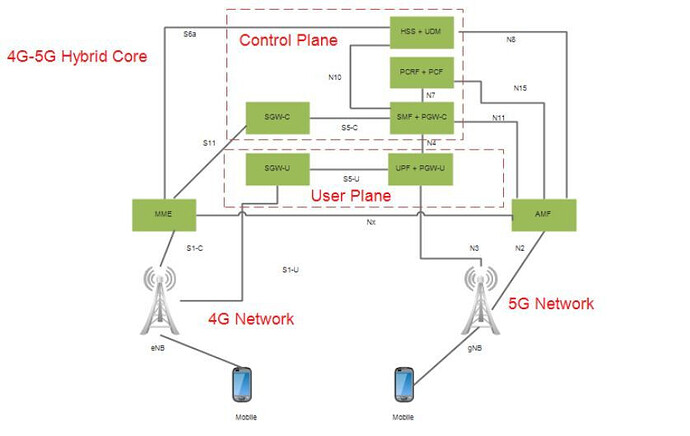As the telecom industry progresses toward fully adopting 5G, the 4G-5G hybrid core has become a vital architecture for ensuring a smooth transition. This architecture allows operators to utilize both 4G (EPC) and 5G (5GC) cores, enabling interoperability and efficient resource utilization.
-
Key Highlights from the Architecture:
-
Control Plane Integration:
- The 4G MME interfaces with the 5G AMF for seamless mobility and session management.
- Components like the HSS + UDM and PCRF + PCF ensure unified authentication and policy control across both generations.
-
User Plane Flexibility:
- The interconnection supports both legacy 4G (eNB) and advanced 5G (gNB) radio networks.
- Nodes like SGW-U and UPF ensure efficient data routing, enabling devices to switch between 4G and 5G networks seamlessly.
-
-
Future-Proofing Networks:
- By leveraging this hybrid setup, operators can maximize their existing investments in 4G infrastructure while gradually deploying 5G capabilities.
-
Example: A Simple Call Flow in a 4G-5G Hybrid Core:
-
Registration: A user equipment (UE) initially connects via a 4G eNB and is authenticated by the MME, interfacing with the HSS.
-
Handover to 5G: When the UE moves to a 5G coverage area, the MME coordinates with the AMF to transfer control signaling.
-
Session Management: The SMF and PGW-C ensure a seamless transition of session continuity between the SGW-U (4G) and UPF (5G).
-
Data Flow: User traffic is routed through the appropriate data plane (e.g., SGW-U for 4G or UPF for 5G), ensuring uninterrupted connectivity.
-
-
Why It Matters:
The hybrid core architecture exemplifies how innovation and backward compatibility can coexist. It ensures uninterrupted service while paving the way for transformative 5G use cases like IoT, ultra-reliable low-latency communication, and enhanced mobile broadband.
LinkedIn: ![]()
